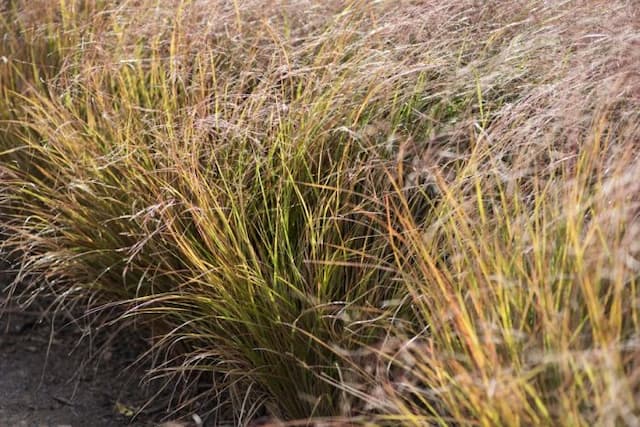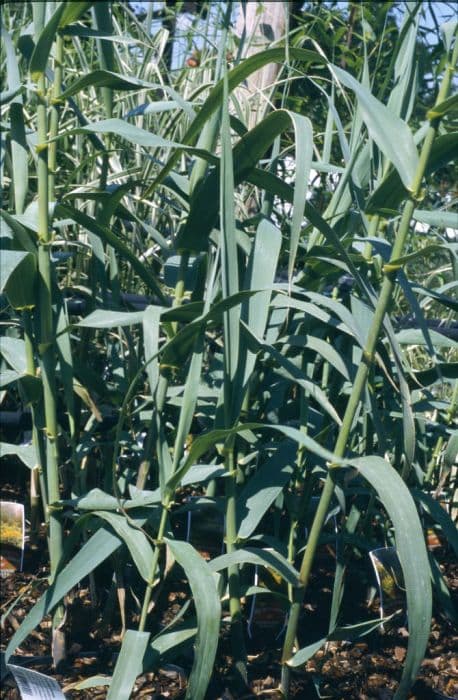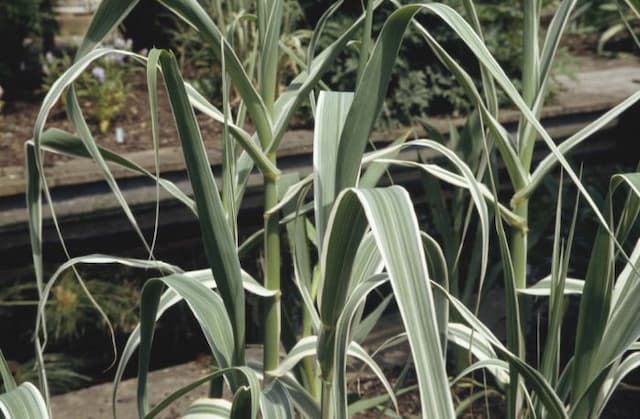Pampas Grass Cortaderia selloana 'Silver Fountain' (v)

ABOUT
The plant commonly known as 'Silver Fountain' Pampas Grass is a visually striking ornamental grass. It displays a graceful, arching form with long, narrow, and elegant leaves that have a predominantly silvery-white coloration. These leaves contrast beautifully with the feathery plumes, which are creamy white to silvery in appearance. These plumes are held aloft on tall, sturdy stalks that rise above the foliage, creating a soft, fluffy texture. Overall, 'Silver Fountain' Pampas Grass is known for its dramatic visual impact and its ability to provide movement and interest in the landscape with its waving plumes in the breeze.
About this plant
 Names
NamesFamily
Poaceae.
Synonyms
Pampas Grass, Silver Fountain Pampas Grass.
Common names
Cortaderia selloana 'Silver Fountain'
 Toxicity
ToxicityTo humans
Pampas grass is not considered to be toxic if ingested by humans. However, the plant's leaves can cause physical irritation due to their sharp edges, which can lead to small cuts or abrasions on the skin. Handling pampas grass without gloves might cause discomfort, but it does not have poisonous properties that would lead to systemic toxic symptoms following ingestion.
To pets
Pampas grass is not known to be toxic to pets. Similar to its effects on humans, the main concern with pets interacting with pampas grass is the mechanical irritation its sharp leaves can cause. There is no documented poisoning from pampas grass ingestion in pets, but it's still advisable to prevent pets from ingesting the plant to avoid potential gastrointestinal upset or injury from the sharp foliage.
 Characteristics
CharacteristicsLife cycle
Perennials
Foliage type
Evergreen
Color of leaves
Varies
Flower color
Mixed
Height
6-8 feet [1.8-2.4 meters]
Spread
4-6 feet [1.2-1.8 meters]
Plant type
Grass
Hardiness zones
7-11
Native area
South America
Benefits
 General Benefits
General Benefits- Visual Appeal: Cortaderia selloana 'Silver Fountain', commonly known as Pampas Grass, is known for its striking, feathery plumes and variegated foliage that add visual interest to any landscape.
- Drought Tolerance: Pampas Grass is highly drought-tolerant once established, making it an ideal choice for water-conservative gardens.
- Low Maintenance: It requires minimal care aside from occasional pruning, which makes it a good option for gardeners seeking low-maintenance plants.
- Privacy Screen: The tall, dense growth of Pampas Grass makes it an effective natural screen for increased privacy in the garden or yard.
- Windbreak: Its robust form can act as a windbreak, protecting smaller plants and garden areas from strong winds.
- Erosion Control: The deep root system of Pampas Grass helps to stabilize soil and prevent erosion, especially on slopes or in areas with loose soil.
- Wildlife Habitat: The plant provides shelter and nesting opportunities for birds, while its seeds can be a food source for wildlife.
 Medical Properties
Medical PropertiesThis plant is not used for medical purposes.
 Air-purifying Qualities
Air-purifying QualitiesThis plant is not specifically known for air purifying qualities.
 Other Uses
Other Uses- Craft Material: The plumes of Pampas Grass can be used for making unique and decorative craft items such as dream catchers or wall hangings, adding a natural and bohemian touch to the decor.
- Themed Events: Pampas Grass can serve as an elegant decoration for events and weddings, particularly for creating a rustic or vintage ambiance.
- Privacy Screen: When planted in groups, Pampas Grass can act as a natural privacy barrier for gardens and outdoor living spaces due to its tall and dense growth.
- Erosion Control: The deep root system of Pampas Grass can help stabilize soil and control erosion on slopes or in areas prone to soil degradation.
- Ornamental Displays: Dried Pampas Grass plumes can be sprayed with metallic or colorful paints to create eye-catching displays for various interior settings.
- Photoshoot Prop: The ethereal quality of Pampas Grass makes it a popular backdrop or prop for photographers, especially in fashion and lifestyle shoots.
- Seasonal Decor: Pampas Grass can be incorporated into autumnal decorations, such as wreaths or centerpieces, to add texture and a natural element to the design.
- Sound Barrier: The thick foliage of Pampas Grass can help to dampen noise when planted along roads or between properties.
- Education: Pampas Grass can be used to educate students about plant life cycles, seed dispersal mechanisms, and invasive species management.
- Film and Theatre: Set designers may use Pampas Grass to create authentic-looking natural environments or as stage props for outdoor scenes.
Interesting Facts
 Feng Shui
Feng ShuiThe plant Pampas Grass is not used in Feng Shui practice.
 Zodiac Sign Compitability
Zodiac Sign CompitabilityThe plant Pampas Grass is not used in astrology practice.
 Plant Symbolism
Plant Symbolism- Beauty: The plant, commonly known as Pampas Grass, has feathery plumes and elegant foliage which make it symbolize natural beauty and grace.
- Resilience: Pampas Grass is known for its toughness and ability to thrive in harsh conditions, representing resilience and hardiness.
- Privacy: Because of its dense growth, Pampas Grass is often used as a natural privacy screen, symbolizing the desire for solitude or personal space.
- Immortality: Pampas Grass dries well and retains its shape, making it a symbol of immortality or everlasting life.
 Water
WaterPampas Grass, specifically the 'Silver Fountain' variety, requires moderate watering, meaning the soil should be kept evenly moist but not waterlogged. Water this plant deeply about once a week, providing roughly 1 to 2 gallons of water for each plant, especially during the growing season or in times of drought. During the winter or in cooler climates, reduce the amount of water to when the top inch of soil feels dry to the touch. It's important to avoid overhead watering to prevent fungal issues, so aim to water at the base of the plant, allowing the water to seep down to the roots.
 Light
LightFor optimal growth, Pampas Grass should be placed in a location where it receives full sun for at least six hours a day. It thrives in bright, unfiltered sunlight, but can tolerate very light shade. It's best to avoid deeply shaded areas, as this can hamper the plant's growth and reduce its remarkable flowering.
 Temperature
TemperaturePampas Grass prefers a temperate climate and can withstand temperatures as low as 20°F for short periods. The optimal growing temperature range for 'Silver Fountain' Pampas Grass is between 65°F and 75°F, but it can survive up to the mid-90s°F during the heat of summer. These plants are relatively adaptable but will not survive in regions where the temperature remains below freezing for extended periods.
 Pruning
PruningPrune Pampas Grass in late winter or early spring, before new growth begins, to remove old foliage and help stimulate new growth. For 'Silver Fountain', cut the foliage back to about 4 to 6 inches above ground level, taking care to wear gloves and protective clothing, as the leaves can have sharp edges. This should be done annually to maintain the plant's shape and encourage healthy, vigorous growth.
 Cleaning
CleaningAs needed
 Soil
SoilPampas Grass prefers well-draining soil with a pH between 6.0 to 7.5. A mix of loam, compost, and coarse sand is ideal to ensure proper drainage and fertility. Regularly adding a layer of organic mulch can boost the soil quality over time.
 Repotting
RepottingPampas Grass does not typically require frequent repotting as it's a large grass and is generally planted directly in the ground. If potted, repot every couple of years or when it outgrows its container.
 Humidity & Misting
Humidity & MistingPampas Grass is tolerant of a wide range of humidity levels. It naturally grows in many environments, so it does not require any special humidity adjustments and can thrive in average outdoor humidity conditions.
 Suitable locations
Suitable locationsIndoor
Provide full sun, well-draining soil, and space for growth.
Outdoor
Plant in full sun, well-drained soil, and protect from strong winds.
Hardiness zone
7-11 USDA
 Life cycle
Life cyclePampas Grass 'Silver Fountain' begins its life cycle as a seed, which when sown in fertile, well-draining soil and exposed to sunlight and warmth, will germinate. It develops a deep root system and starts to produce long, arching leaves that form a dense, tussock-like clump. As the plant matures, typically by its third year, it sends up tall, silvery-white plumes which can reach several feet above the foliage in the summer and autumn. These plumes are the plant's inflorescences, which contain numerous tiny flowers capable of producing seeds for reproduction. After pollination, seeds are dispersed by wind, enabling the colonization of new areas. Pampas Grass 'Silver Fountain' is a perennial, entering a dormancy phase in winter where growth slows down substantially, and then resumes the cycle in spring with fresh growth.
 Propogation
PropogationPropogation time
Spring-Early Summer
Pampas grass 'Silver Fountain' is commonly propagated by division, a method that is most effectively carried out in the late winter or early spring. During this time, the plant is still dormant, which reduces stress and allows it to recover more effectively once replanted. To propagate by division, you need to dig up the entire clump of the pampas grass and then separate it into smaller segments, ensuring that each section has a good amount of roots attached. These sections can then be replanted in prepared soil, spaced at a distance of no less than 6 feet (about 1.8 meters) to accommodate the mature size of the grass. Watering should be done regularly to help establish the new clumps, and within a season, these divisions can grow into full-sized plants. This method is favored for its simplicity and effectiveness in expanding your garden's display of pampas grass.









